Improvising Biometric and Biometric Data Using a Combination of Behavior Identifier and Using BlockChain Systems to Securing Information in Healthcare Industry
VerifiedAdded on 2022/09/05
|12
|2558
|18
AI Summary
Contribute Materials
Your contribution can guide someone’s learning journey. Share your
documents today.
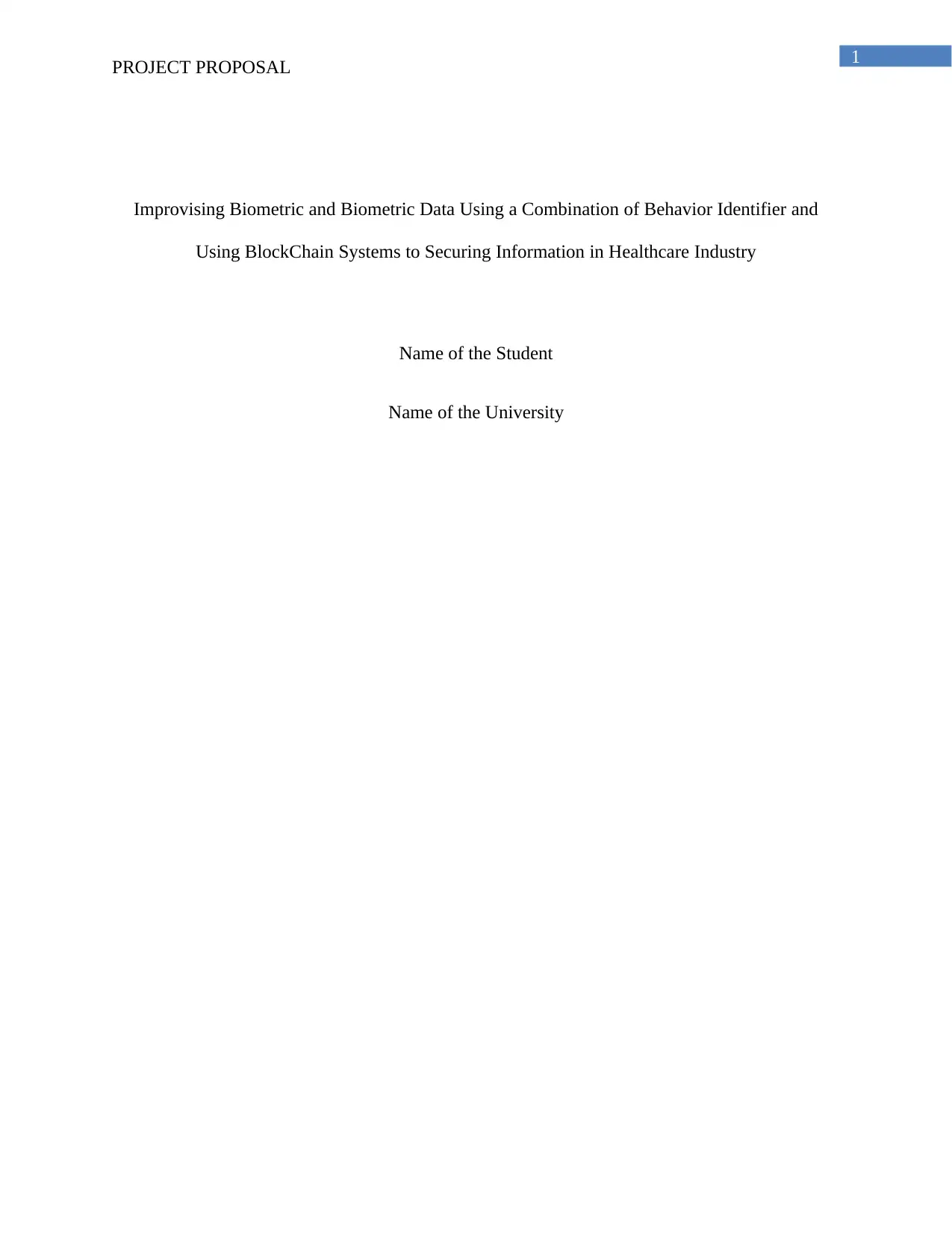
1
PROJECT PROPOSAL
Improvising Biometric and Biometric Data Using a Combination of Behavior Identifier and
Using BlockChain Systems to Securing Information in Healthcare Industry
Name of the Student
Name of the University
PROJECT PROPOSAL
Improvising Biometric and Biometric Data Using a Combination of Behavior Identifier and
Using BlockChain Systems to Securing Information in Healthcare Industry
Name of the Student
Name of the University
Secure Best Marks with AI Grader
Need help grading? Try our AI Grader for instant feedback on your assignments.
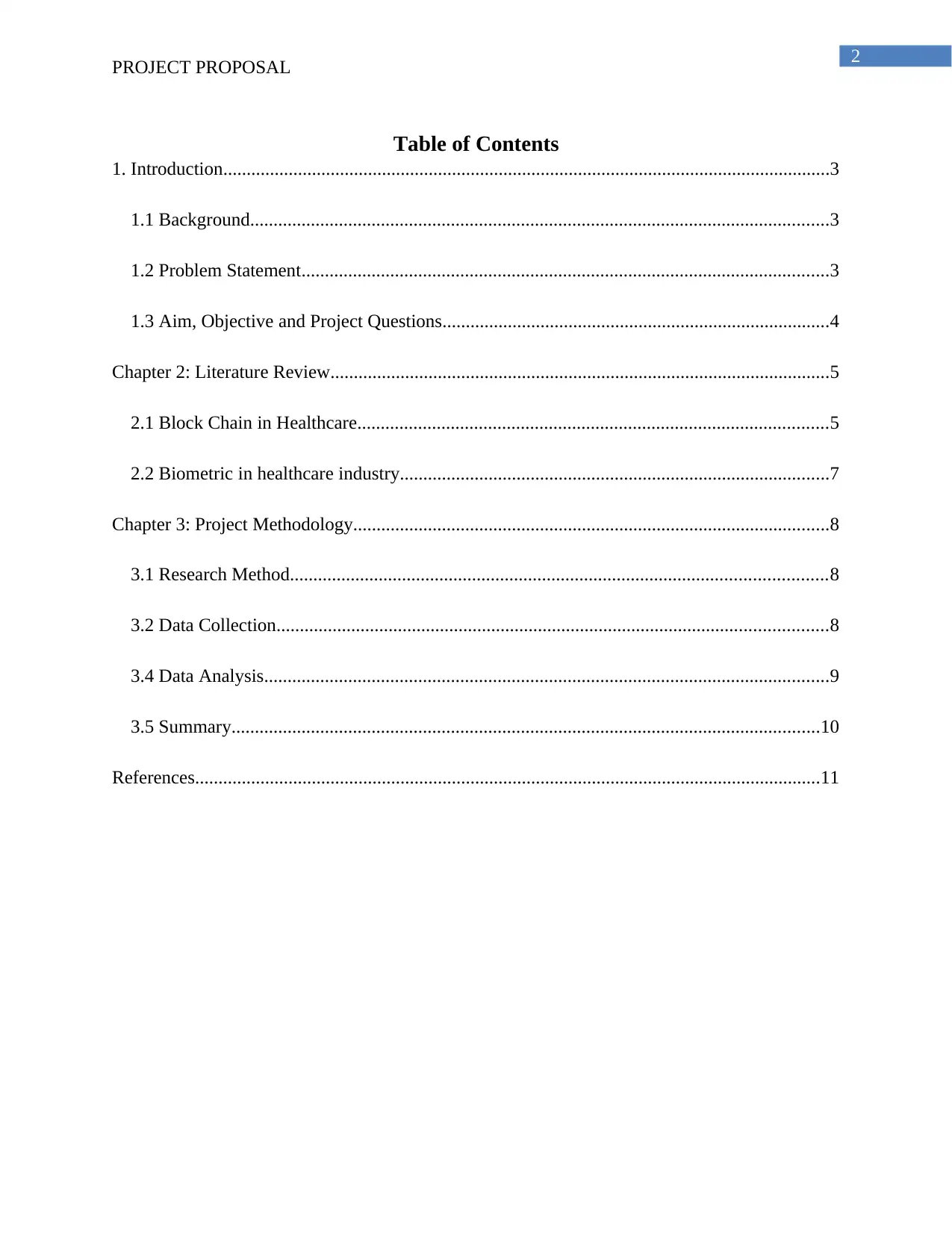
2
PROJECT PROPOSAL
Table of Contents
1. Introduction..................................................................................................................................3
1.1 Background............................................................................................................................3
1.2 Problem Statement.................................................................................................................3
1.3 Aim, Objective and Project Questions...................................................................................4
Chapter 2: Literature Review...........................................................................................................5
2.1 Block Chain in Healthcare.....................................................................................................5
2.2 Biometric in healthcare industry............................................................................................7
Chapter 3: Project Methodology......................................................................................................8
3.1 Research Method...................................................................................................................8
3.2 Data Collection......................................................................................................................8
3.4 Data Analysis.........................................................................................................................9
3.5 Summary..............................................................................................................................10
References......................................................................................................................................11
PROJECT PROPOSAL
Table of Contents
1. Introduction..................................................................................................................................3
1.1 Background............................................................................................................................3
1.2 Problem Statement.................................................................................................................3
1.3 Aim, Objective and Project Questions...................................................................................4
Chapter 2: Literature Review...........................................................................................................5
2.1 Block Chain in Healthcare.....................................................................................................5
2.2 Biometric in healthcare industry............................................................................................7
Chapter 3: Project Methodology......................................................................................................8
3.1 Research Method...................................................................................................................8
3.2 Data Collection......................................................................................................................8
3.4 Data Analysis.........................................................................................................................9
3.5 Summary..............................................................................................................................10
References......................................................................................................................................11
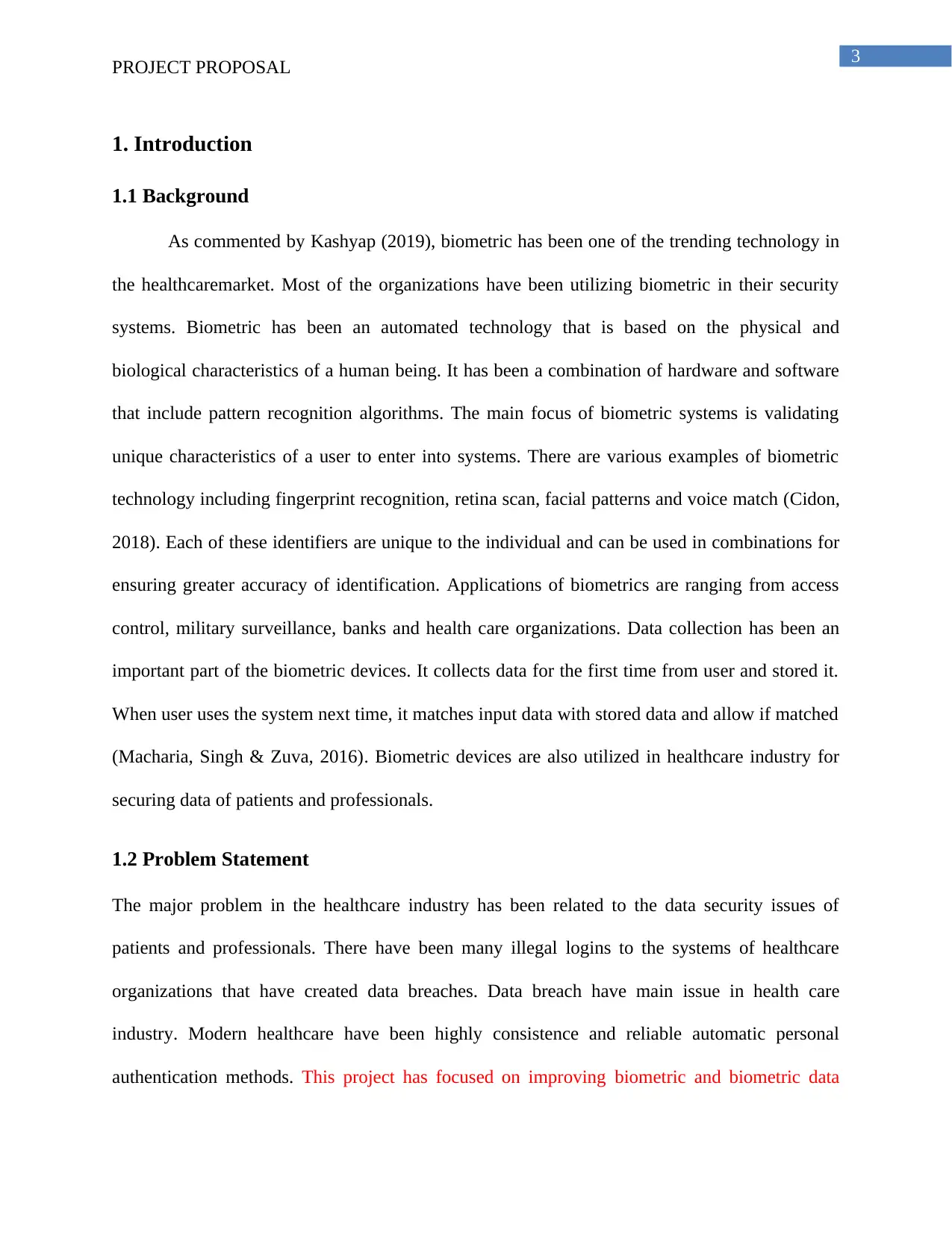
3
PROJECT PROPOSAL
1. Introduction
1.1 Background
As commented by Kashyap (2019), biometric has been one of the trending technology in
the healthcaremarket. Most of the organizations have been utilizing biometric in their security
systems. Biometric has been an automated technology that is based on the physical and
biological characteristics of a human being. It has been a combination of hardware and software
that include pattern recognition algorithms. The main focus of biometric systems is validating
unique characteristics of a user to enter into systems. There are various examples of biometric
technology including fingerprint recognition, retina scan, facial patterns and voice match (Cidon,
2018). Each of these identifiers are unique to the individual and can be used in combinations for
ensuring greater accuracy of identification. Applications of biometrics are ranging from access
control, military surveillance, banks and health care organizations. Data collection has been an
important part of the biometric devices. It collects data for the first time from user and stored it.
When user uses the system next time, it matches input data with stored data and allow if matched
(Macharia, Singh & Zuva, 2016). Biometric devices are also utilized in healthcare industry for
securing data of patients and professionals.
1.2 Problem Statement
The major problem in the healthcare industry has been related to the data security issues of
patients and professionals. There have been many illegal logins to the systems of healthcare
organizations that have created data breaches. Data breach have main issue in health care
industry. Modern healthcare have been highly consistence and reliable automatic personal
authentication methods. This project has focused on improving biometric and biometric data
PROJECT PROPOSAL
1. Introduction
1.1 Background
As commented by Kashyap (2019), biometric has been one of the trending technology in
the healthcaremarket. Most of the organizations have been utilizing biometric in their security
systems. Biometric has been an automated technology that is based on the physical and
biological characteristics of a human being. It has been a combination of hardware and software
that include pattern recognition algorithms. The main focus of biometric systems is validating
unique characteristics of a user to enter into systems. There are various examples of biometric
technology including fingerprint recognition, retina scan, facial patterns and voice match (Cidon,
2018). Each of these identifiers are unique to the individual and can be used in combinations for
ensuring greater accuracy of identification. Applications of biometrics are ranging from access
control, military surveillance, banks and health care organizations. Data collection has been an
important part of the biometric devices. It collects data for the first time from user and stored it.
When user uses the system next time, it matches input data with stored data and allow if matched
(Macharia, Singh & Zuva, 2016). Biometric devices are also utilized in healthcare industry for
securing data of patients and professionals.
1.2 Problem Statement
The major problem in the healthcare industry has been related to the data security issues of
patients and professionals. There have been many illegal logins to the systems of healthcare
organizations that have created data breaches. Data breach have main issue in health care
industry. Modern healthcare have been highly consistence and reliable automatic personal
authentication methods. This project has focused on improving biometric and biometric data
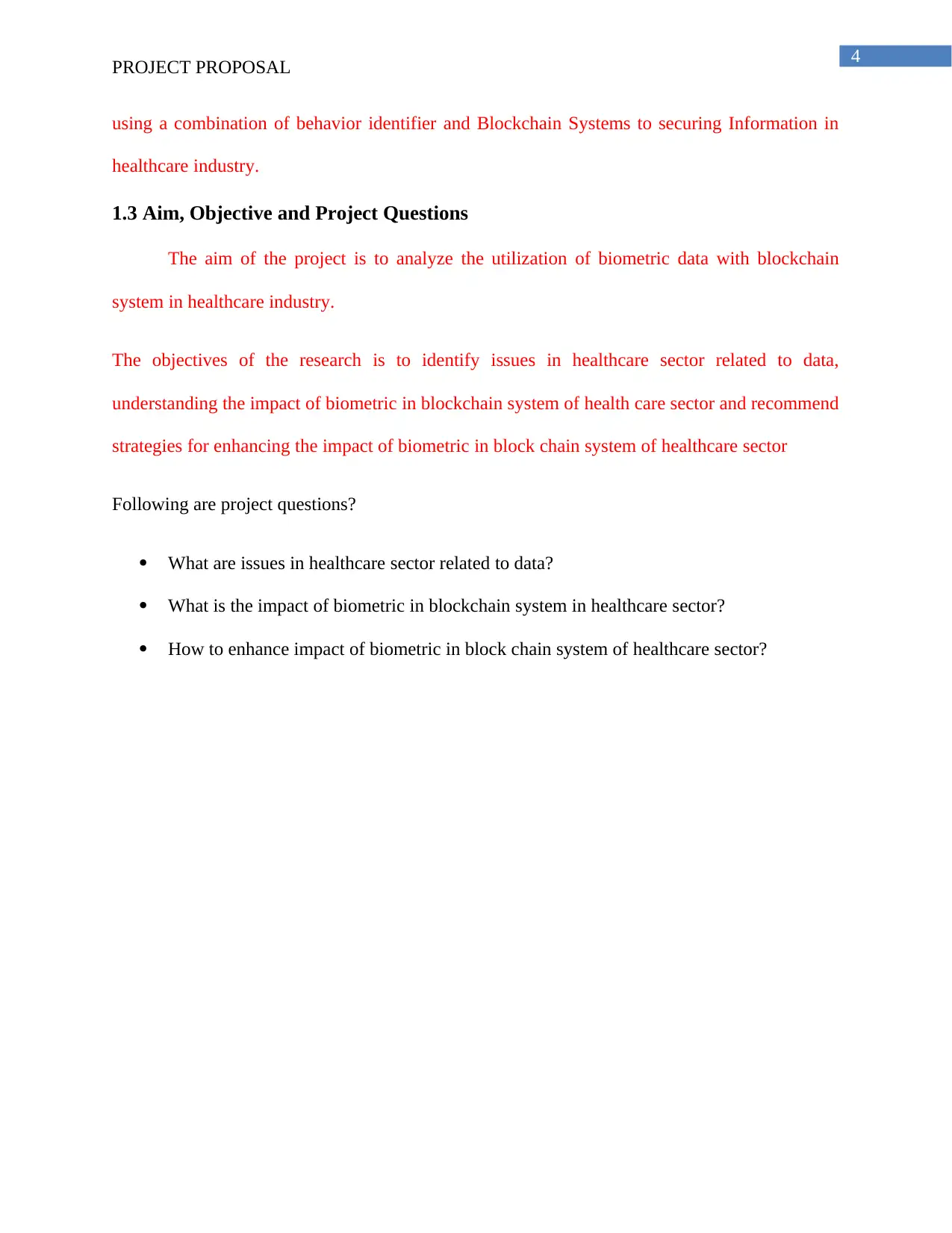
4
PROJECT PROPOSAL
using a combination of behavior identifier and Blockchain Systems to securing Information in
healthcare industry.
1.3 Aim, Objective and Project Questions
The aim of the project is to analyze the utilization of biometric data with blockchain
system in healthcare industry.
The objectives of the research is to identify issues in healthcare sector related to data,
understanding the impact of biometric in blockchain system of health care sector and recommend
strategies for enhancing the impact of biometric in block chain system of healthcare sector
Following are project questions?
What are issues in healthcare sector related to data?
What is the impact of biometric in blockchain system in healthcare sector?
How to enhance impact of biometric in block chain system of healthcare sector?
PROJECT PROPOSAL
using a combination of behavior identifier and Blockchain Systems to securing Information in
healthcare industry.
1.3 Aim, Objective and Project Questions
The aim of the project is to analyze the utilization of biometric data with blockchain
system in healthcare industry.
The objectives of the research is to identify issues in healthcare sector related to data,
understanding the impact of biometric in blockchain system of health care sector and recommend
strategies for enhancing the impact of biometric in block chain system of healthcare sector
Following are project questions?
What are issues in healthcare sector related to data?
What is the impact of biometric in blockchain system in healthcare sector?
How to enhance impact of biometric in block chain system of healthcare sector?
Secure Best Marks with AI Grader
Need help grading? Try our AI Grader for instant feedback on your assignments.
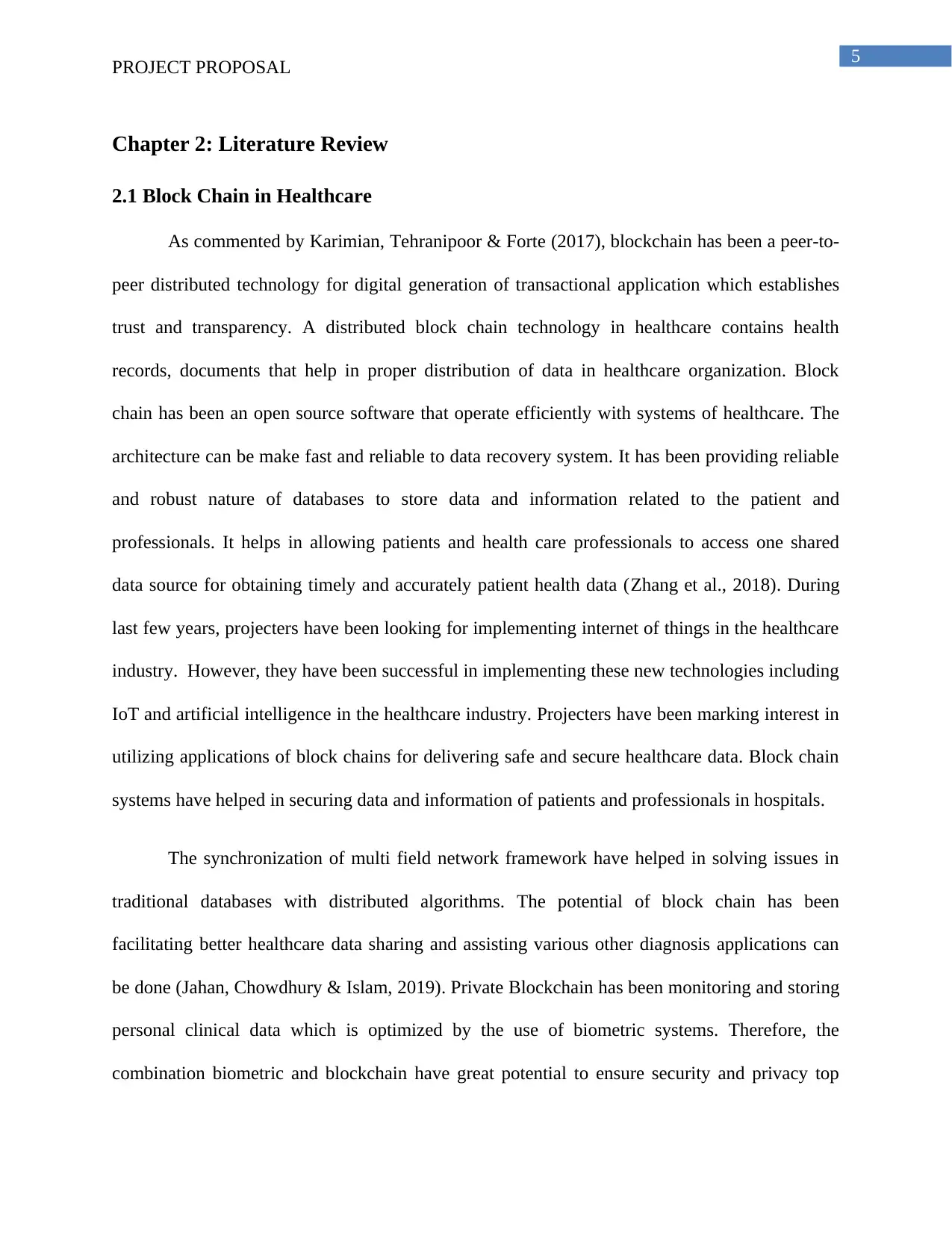
5
PROJECT PROPOSAL
Chapter 2: Literature Review
2.1 Block Chain in Healthcare
As commented by Karimian, Tehranipoor & Forte (2017), blockchain has been a peer-to-
peer distributed technology for digital generation of transactional application which establishes
trust and transparency. A distributed block chain technology in healthcare contains health
records, documents that help in proper distribution of data in healthcare organization. Block
chain has been an open source software that operate efficiently with systems of healthcare. The
architecture can be make fast and reliable to data recovery system. It has been providing reliable
and robust nature of databases to store data and information related to the patient and
professionals. It helps in allowing patients and health care professionals to access one shared
data source for obtaining timely and accurately patient health data (Zhang et al., 2018). During
last few years, projecters have been looking for implementing internet of things in the healthcare
industry. However, they have been successful in implementing these new technologies including
IoT and artificial intelligence in the healthcare industry. Projecters have been marking interest in
utilizing applications of block chains for delivering safe and secure healthcare data. Block chain
systems have helped in securing data and information of patients and professionals in hospitals.
The synchronization of multi field network framework have helped in solving issues in
traditional databases with distributed algorithms. The potential of block chain has been
facilitating better healthcare data sharing and assisting various other diagnosis applications can
be done (Jahan, Chowdhury & Islam, 2019). Private Blockchain has been monitoring and storing
personal clinical data which is optimized by the use of biometric systems. Therefore, the
combination biometric and blockchain have great potential to ensure security and privacy top
PROJECT PROPOSAL
Chapter 2: Literature Review
2.1 Block Chain in Healthcare
As commented by Karimian, Tehranipoor & Forte (2017), blockchain has been a peer-to-
peer distributed technology for digital generation of transactional application which establishes
trust and transparency. A distributed block chain technology in healthcare contains health
records, documents that help in proper distribution of data in healthcare organization. Block
chain has been an open source software that operate efficiently with systems of healthcare. The
architecture can be make fast and reliable to data recovery system. It has been providing reliable
and robust nature of databases to store data and information related to the patient and
professionals. It helps in allowing patients and health care professionals to access one shared
data source for obtaining timely and accurately patient health data (Zhang et al., 2018). During
last few years, projecters have been looking for implementing internet of things in the healthcare
industry. However, they have been successful in implementing these new technologies including
IoT and artificial intelligence in the healthcare industry. Projecters have been marking interest in
utilizing applications of block chains for delivering safe and secure healthcare data. Block chain
systems have helped in securing data and information of patients and professionals in hospitals.
The synchronization of multi field network framework have helped in solving issues in
traditional databases with distributed algorithms. The potential of block chain has been
facilitating better healthcare data sharing and assisting various other diagnosis applications can
be done (Jahan, Chowdhury & Islam, 2019). Private Blockchain has been monitoring and storing
personal clinical data which is optimized by the use of biometric systems. Therefore, the
combination biometric and blockchain have great potential to ensure security and privacy top
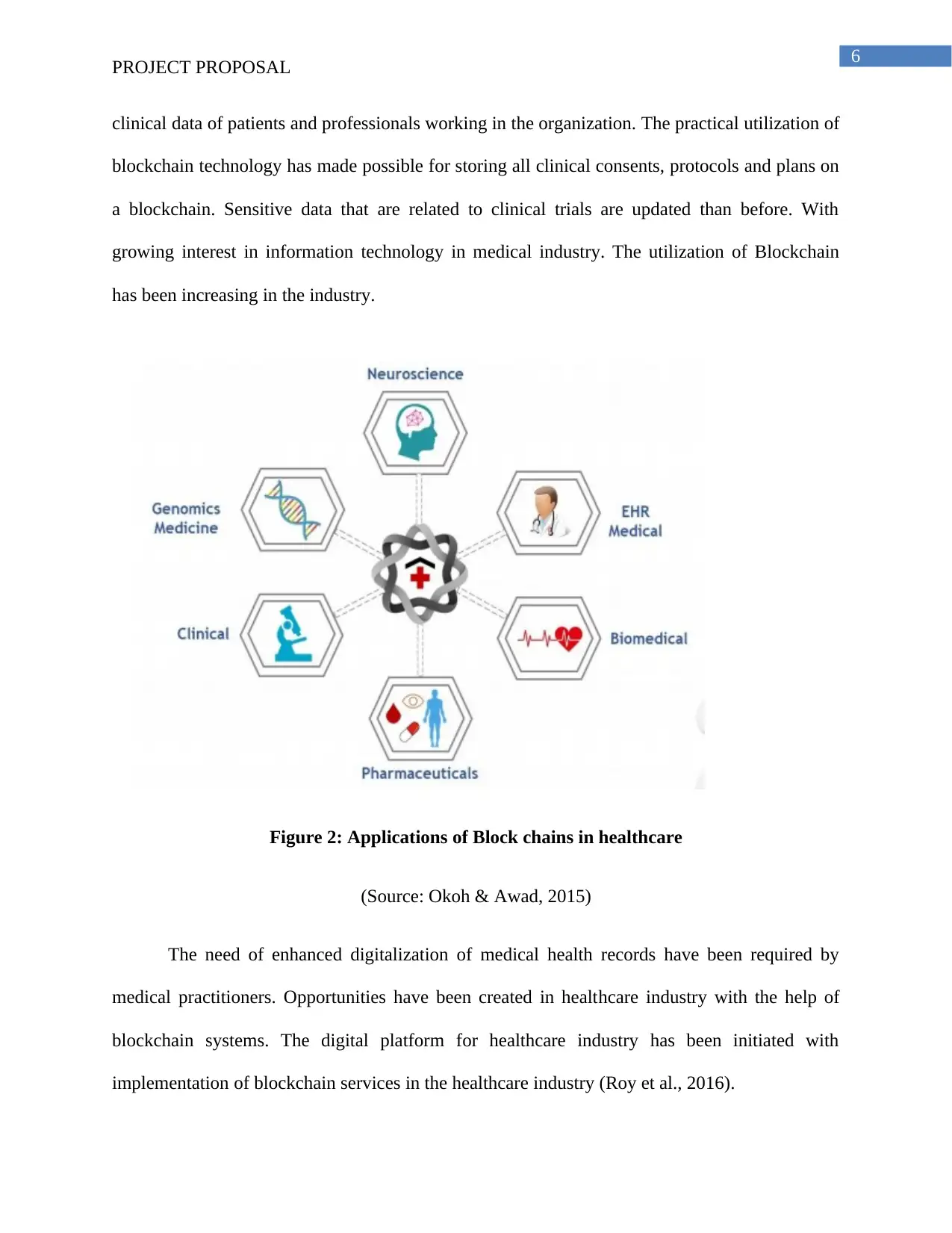
6
PROJECT PROPOSAL
clinical data of patients and professionals working in the organization. The practical utilization of
blockchain technology has made possible for storing all clinical consents, protocols and plans on
a blockchain. Sensitive data that are related to clinical trials are updated than before. With
growing interest in information technology in medical industry. The utilization of Blockchain
has been increasing in the industry.
Figure 2: Applications of Block chains in healthcare
(Source: Okoh & Awad, 2015)
The need of enhanced digitalization of medical health records have been required by
medical practitioners. Opportunities have been created in healthcare industry with the help of
blockchain systems. The digital platform for healthcare industry has been initiated with
implementation of blockchain services in the healthcare industry (Roy et al., 2016).
PROJECT PROPOSAL
clinical data of patients and professionals working in the organization. The practical utilization of
blockchain technology has made possible for storing all clinical consents, protocols and plans on
a blockchain. Sensitive data that are related to clinical trials are updated than before. With
growing interest in information technology in medical industry. The utilization of Blockchain
has been increasing in the industry.
Figure 2: Applications of Block chains in healthcare
(Source: Okoh & Awad, 2015)
The need of enhanced digitalization of medical health records have been required by
medical practitioners. Opportunities have been created in healthcare industry with the help of
blockchain systems. The digital platform for healthcare industry has been initiated with
implementation of blockchain services in the healthcare industry (Roy et al., 2016).
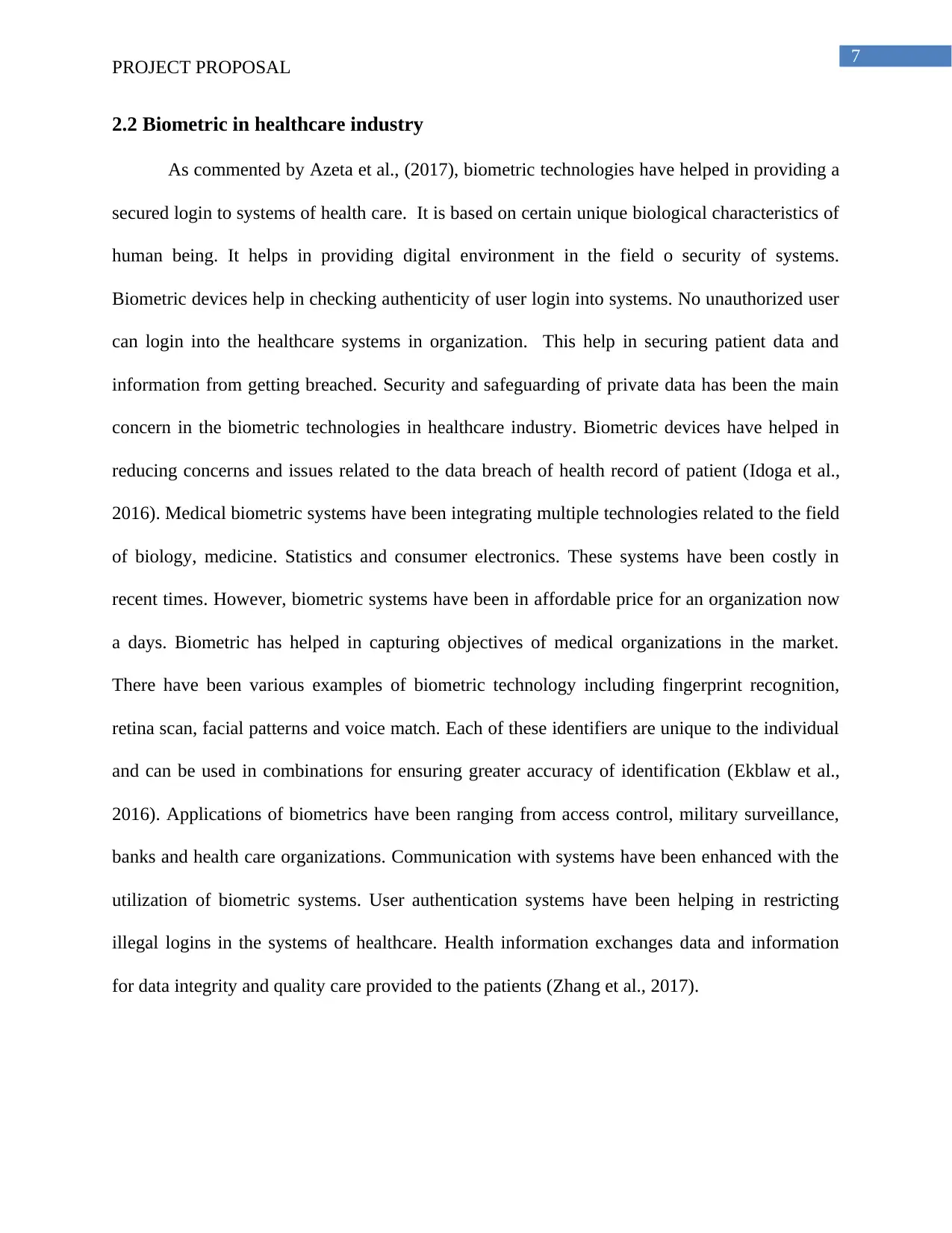
7
PROJECT PROPOSAL
2.2 Biometric in healthcare industry
As commented by Azeta et al., (2017), biometric technologies have helped in providing a
secured login to systems of health care. It is based on certain unique biological characteristics of
human being. It helps in providing digital environment in the field o security of systems.
Biometric devices help in checking authenticity of user login into systems. No unauthorized user
can login into the healthcare systems in organization. This help in securing patient data and
information from getting breached. Security and safeguarding of private data has been the main
concern in the biometric technologies in healthcare industry. Biometric devices have helped in
reducing concerns and issues related to the data breach of health record of patient (Idoga et al.,
2016). Medical biometric systems have been integrating multiple technologies related to the field
of biology, medicine. Statistics and consumer electronics. These systems have been costly in
recent times. However, biometric systems have been in affordable price for an organization now
a days. Biometric has helped in capturing objectives of medical organizations in the market.
There have been various examples of biometric technology including fingerprint recognition,
retina scan, facial patterns and voice match. Each of these identifiers are unique to the individual
and can be used in combinations for ensuring greater accuracy of identification (Ekblaw et al.,
2016). Applications of biometrics have been ranging from access control, military surveillance,
banks and health care organizations. Communication with systems have been enhanced with the
utilization of biometric systems. User authentication systems have been helping in restricting
illegal logins in the systems of healthcare. Health information exchanges data and information
for data integrity and quality care provided to the patients (Zhang et al., 2017).
PROJECT PROPOSAL
2.2 Biometric in healthcare industry
As commented by Azeta et al., (2017), biometric technologies have helped in providing a
secured login to systems of health care. It is based on certain unique biological characteristics of
human being. It helps in providing digital environment in the field o security of systems.
Biometric devices help in checking authenticity of user login into systems. No unauthorized user
can login into the healthcare systems in organization. This help in securing patient data and
information from getting breached. Security and safeguarding of private data has been the main
concern in the biometric technologies in healthcare industry. Biometric devices have helped in
reducing concerns and issues related to the data breach of health record of patient (Idoga et al.,
2016). Medical biometric systems have been integrating multiple technologies related to the field
of biology, medicine. Statistics and consumer electronics. These systems have been costly in
recent times. However, biometric systems have been in affordable price for an organization now
a days. Biometric has helped in capturing objectives of medical organizations in the market.
There have been various examples of biometric technology including fingerprint recognition,
retina scan, facial patterns and voice match. Each of these identifiers are unique to the individual
and can be used in combinations for ensuring greater accuracy of identification (Ekblaw et al.,
2016). Applications of biometrics have been ranging from access control, military surveillance,
banks and health care organizations. Communication with systems have been enhanced with the
utilization of biometric systems. User authentication systems have been helping in restricting
illegal logins in the systems of healthcare. Health information exchanges data and information
for data integrity and quality care provided to the patients (Zhang et al., 2017).
Paraphrase This Document
Need a fresh take? Get an instant paraphrase of this document with our AI Paraphraser
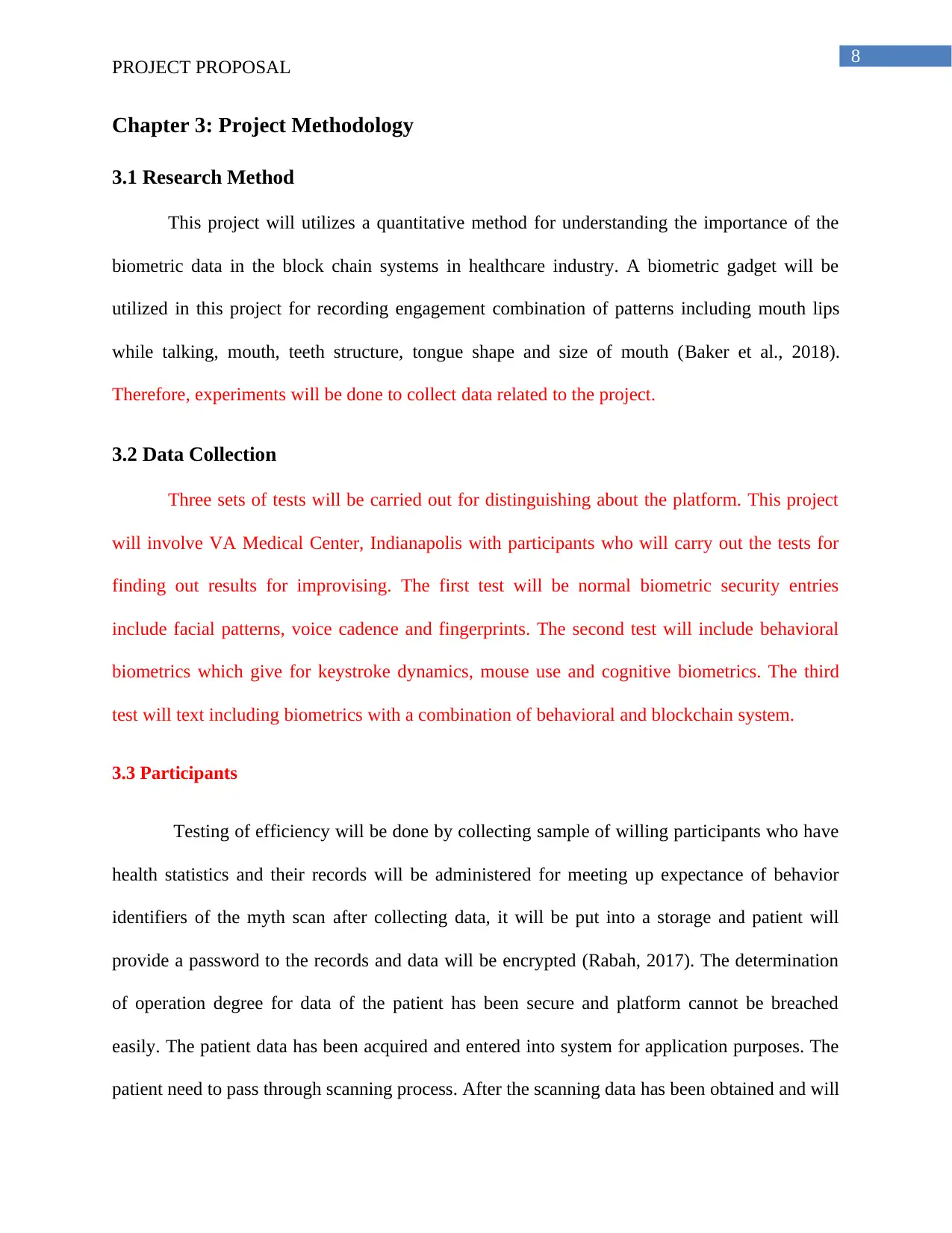
8
PROJECT PROPOSAL
Chapter 3: Project Methodology
3.1 Research Method
This project will utilizes a quantitative method for understanding the importance of the
biometric data in the block chain systems in healthcare industry. A biometric gadget will be
utilized in this project for recording engagement combination of patterns including mouth lips
while talking, mouth, teeth structure, tongue shape and size of mouth (Baker et al., 2018).
Therefore, experiments will be done to collect data related to the project.
3.2 Data Collection
Three sets of tests will be carried out for distinguishing about the platform. This project
will involve VA Medical Center, Indianapolis with participants who will carry out the tests for
finding out results for improvising. The first test will be normal biometric security entries
include facial patterns, voice cadence and fingerprints. The second test will include behavioral
biometrics which give for keystroke dynamics, mouse use and cognitive biometrics. The third
test will text including biometrics with a combination of behavioral and blockchain system.
3.3 Participants
Testing of efficiency will be done by collecting sample of willing participants who have
health statistics and their records will be administered for meeting up expectance of behavior
identifiers of the myth scan after collecting data, it will be put into a storage and patient will
provide a password to the records and data will be encrypted (Rabah, 2017). The determination
of operation degree for data of the patient has been secure and platform cannot be breached
easily. The patient data has been acquired and entered into system for application purposes. The
patient need to pass through scanning process. After the scanning data has been obtained and will
PROJECT PROPOSAL
Chapter 3: Project Methodology
3.1 Research Method
This project will utilizes a quantitative method for understanding the importance of the
biometric data in the block chain systems in healthcare industry. A biometric gadget will be
utilized in this project for recording engagement combination of patterns including mouth lips
while talking, mouth, teeth structure, tongue shape and size of mouth (Baker et al., 2018).
Therefore, experiments will be done to collect data related to the project.
3.2 Data Collection
Three sets of tests will be carried out for distinguishing about the platform. This project
will involve VA Medical Center, Indianapolis with participants who will carry out the tests for
finding out results for improvising. The first test will be normal biometric security entries
include facial patterns, voice cadence and fingerprints. The second test will include behavioral
biometrics which give for keystroke dynamics, mouse use and cognitive biometrics. The third
test will text including biometrics with a combination of behavioral and blockchain system.
3.3 Participants
Testing of efficiency will be done by collecting sample of willing participants who have
health statistics and their records will be administered for meeting up expectance of behavior
identifiers of the myth scan after collecting data, it will be put into a storage and patient will
provide a password to the records and data will be encrypted (Rabah, 2017). The determination
of operation degree for data of the patient has been secure and platform cannot be breached
easily. The patient data has been acquired and entered into system for application purposes. The
patient need to pass through scanning process. After the scanning data has been obtained and will
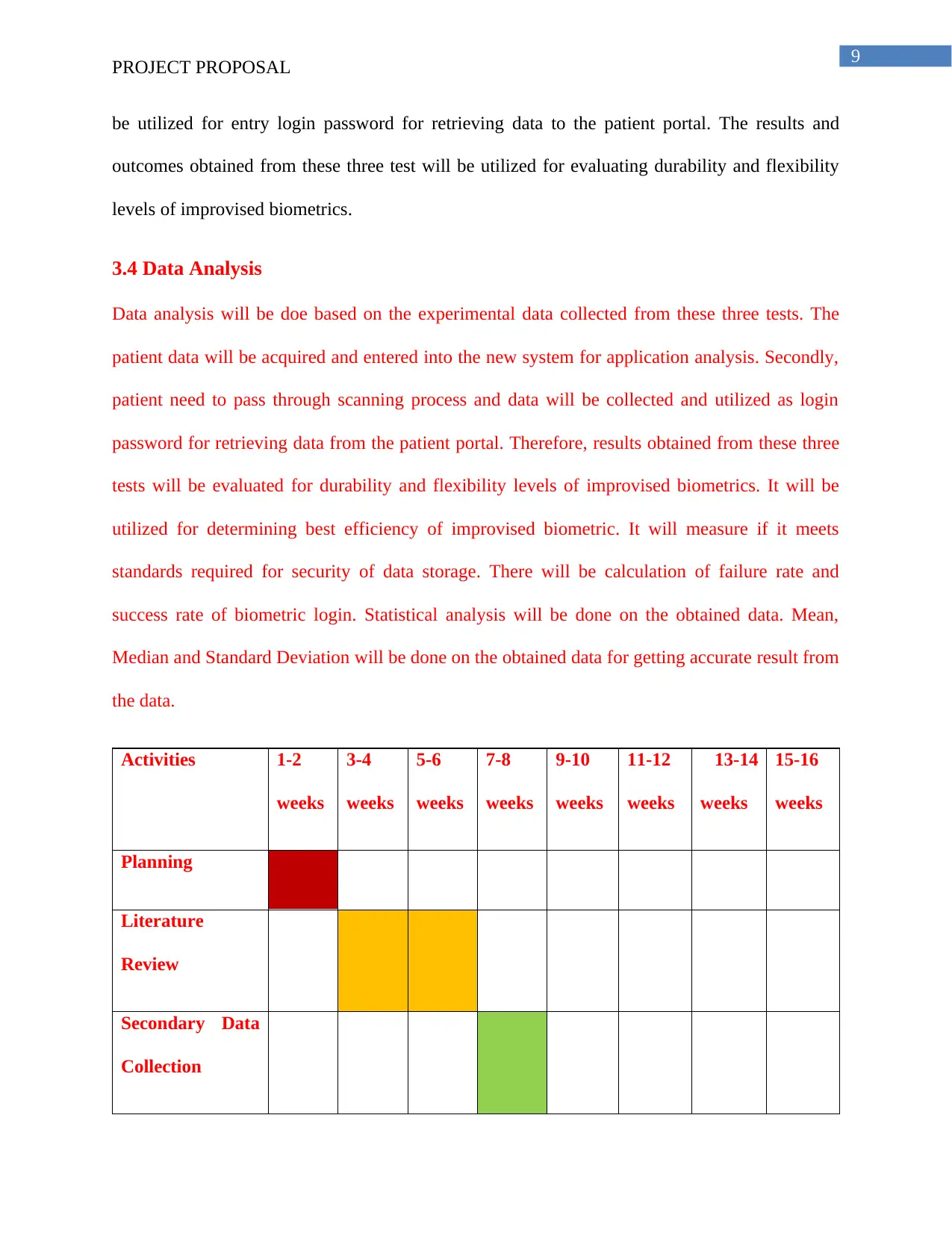
9
PROJECT PROPOSAL
be utilized for entry login password for retrieving data to the patient portal. The results and
outcomes obtained from these three test will be utilized for evaluating durability and flexibility
levels of improvised biometrics.
3.4 Data Analysis
Data analysis will be doe based on the experimental data collected from these three tests. The
patient data will be acquired and entered into the new system for application analysis. Secondly,
patient need to pass through scanning process and data will be collected and utilized as login
password for retrieving data from the patient portal. Therefore, results obtained from these three
tests will be evaluated for durability and flexibility levels of improvised biometrics. It will be
utilized for determining best efficiency of improvised biometric. It will measure if it meets
standards required for security of data storage. There will be calculation of failure rate and
success rate of biometric login. Statistical analysis will be done on the obtained data. Mean,
Median and Standard Deviation will be done on the obtained data for getting accurate result from
the data.
Activities 1-2
weeks
3-4
weeks
5-6
weeks
7-8
weeks
9-10
weeks
11-12
weeks
13-14
weeks
15-16
weeks
Planning
Literature
Review
Secondary Data
Collection
PROJECT PROPOSAL
be utilized for entry login password for retrieving data to the patient portal. The results and
outcomes obtained from these three test will be utilized for evaluating durability and flexibility
levels of improvised biometrics.
3.4 Data Analysis
Data analysis will be doe based on the experimental data collected from these three tests. The
patient data will be acquired and entered into the new system for application analysis. Secondly,
patient need to pass through scanning process and data will be collected and utilized as login
password for retrieving data from the patient portal. Therefore, results obtained from these three
tests will be evaluated for durability and flexibility levels of improvised biometrics. It will be
utilized for determining best efficiency of improvised biometric. It will measure if it meets
standards required for security of data storage. There will be calculation of failure rate and
success rate of biometric login. Statistical analysis will be done on the obtained data. Mean,
Median and Standard Deviation will be done on the obtained data for getting accurate result from
the data.
Activities 1-2
weeks
3-4
weeks
5-6
weeks
7-8
weeks
9-10
weeks
11-12
weeks
13-14
weeks
15-16
weeks
Planning
Literature
Review
Secondary Data
Collection
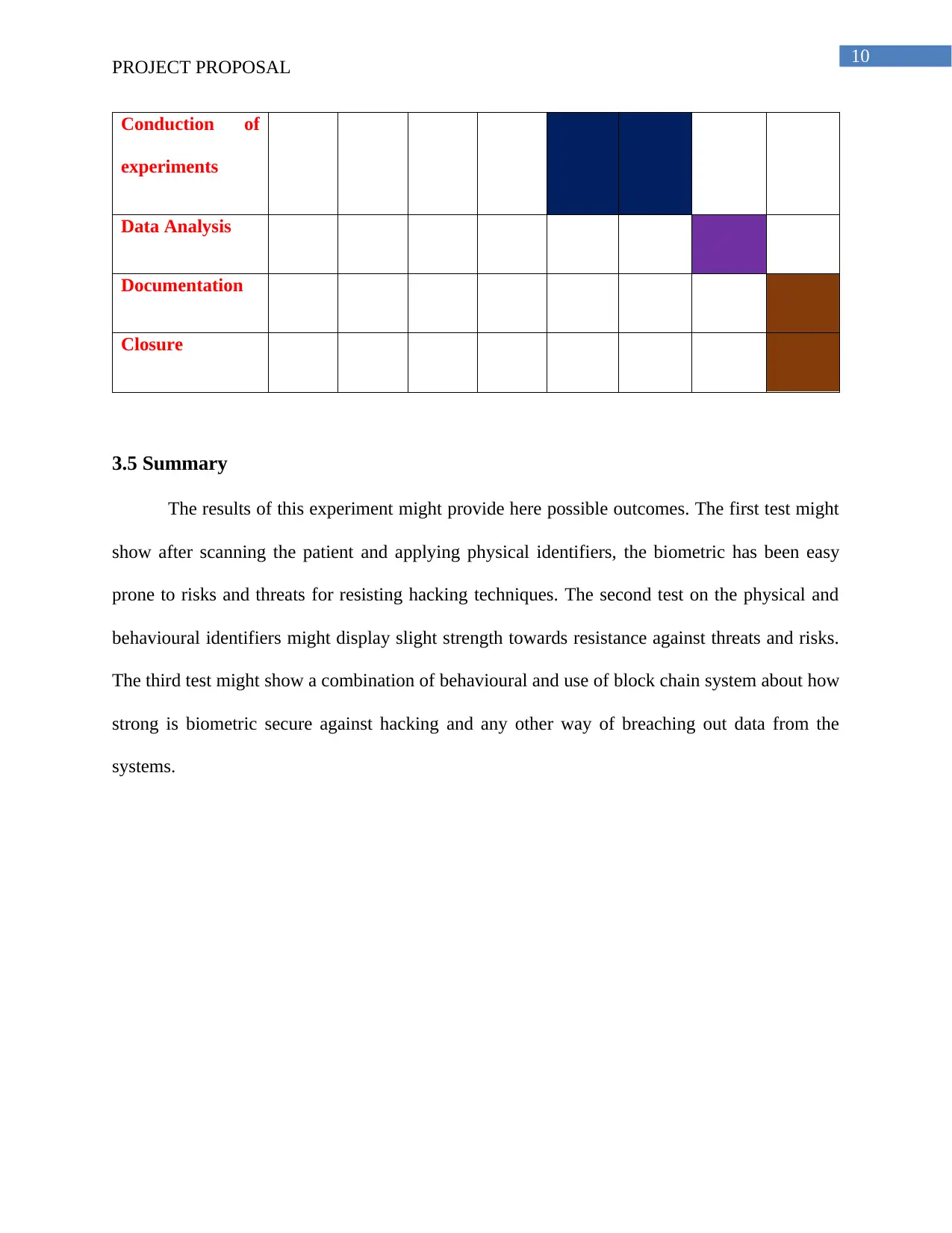
10
PROJECT PROPOSAL
Conduction of
experiments
Data Analysis
Documentation
Closure
3.5 Summary
The results of this experiment might provide here possible outcomes. The first test might
show after scanning the patient and applying physical identifiers, the biometric has been easy
prone to risks and threats for resisting hacking techniques. The second test on the physical and
behavioural identifiers might display slight strength towards resistance against threats and risks.
The third test might show a combination of behavioural and use of block chain system about how
strong is biometric secure against hacking and any other way of breaching out data from the
systems.
PROJECT PROPOSAL
Conduction of
experiments
Data Analysis
Documentation
Closure
3.5 Summary
The results of this experiment might provide here possible outcomes. The first test might
show after scanning the patient and applying physical identifiers, the biometric has been easy
prone to risks and threats for resisting hacking techniques. The second test on the physical and
behavioural identifiers might display slight strength towards resistance against threats and risks.
The third test might show a combination of behavioural and use of block chain system about how
strong is biometric secure against hacking and any other way of breaching out data from the
systems.
Secure Best Marks with AI Grader
Need help grading? Try our AI Grader for instant feedback on your assignments.
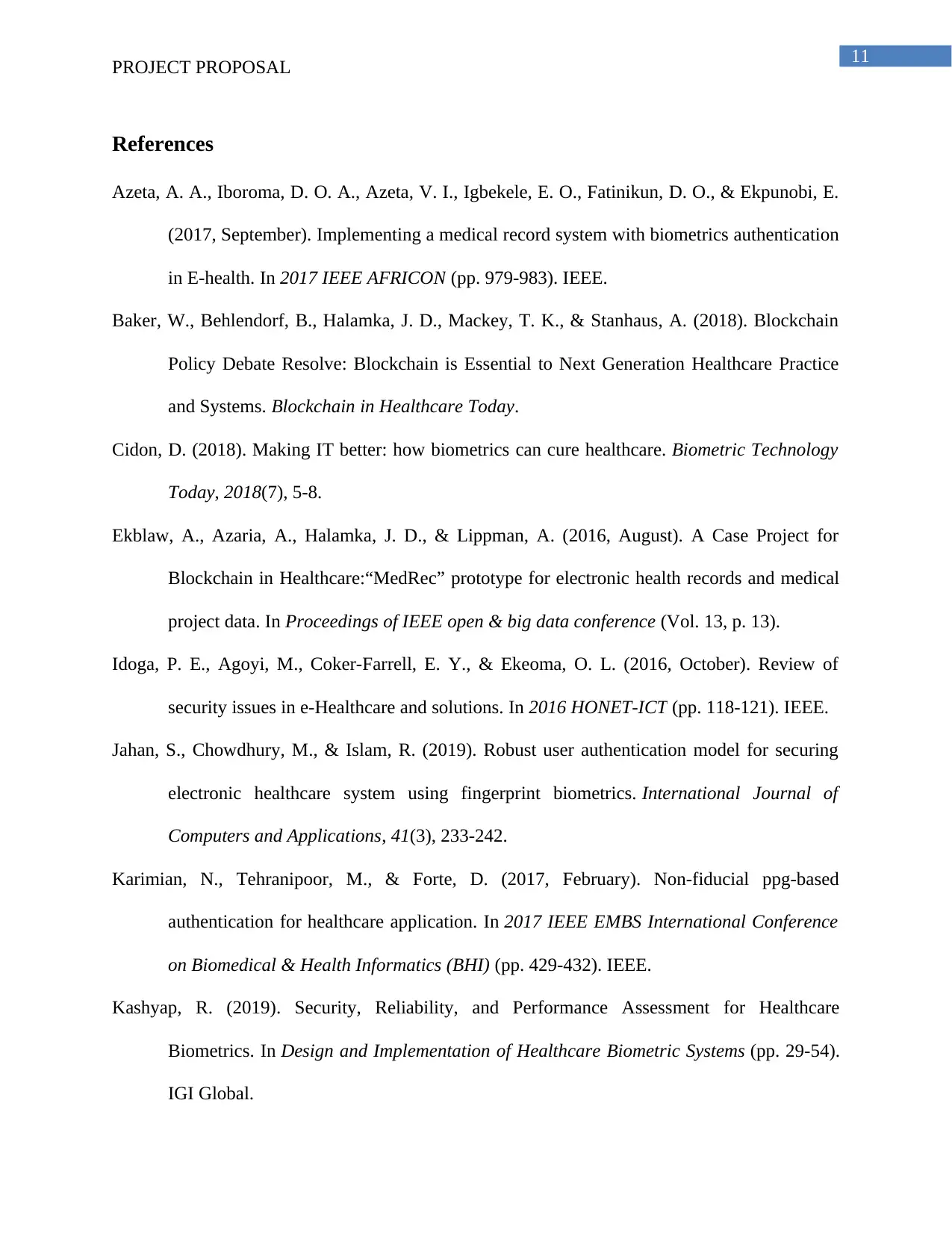
11
PROJECT PROPOSAL
References
Azeta, A. A., Iboroma, D. O. A., Azeta, V. I., Igbekele, E. O., Fatinikun, D. O., & Ekpunobi, E.
(2017, September). Implementing a medical record system with biometrics authentication
in E-health. In 2017 IEEE AFRICON (pp. 979-983). IEEE.
Baker, W., Behlendorf, B., Halamka, J. D., Mackey, T. K., & Stanhaus, A. (2018). Blockchain
Policy Debate Resolve: Blockchain is Essential to Next Generation Healthcare Practice
and Systems. Blockchain in Healthcare Today.
Cidon, D. (2018). Making IT better: how biometrics can cure healthcare. Biometric Technology
Today, 2018(7), 5-8.
Ekblaw, A., Azaria, A., Halamka, J. D., & Lippman, A. (2016, August). A Case Project for
Blockchain in Healthcare:“MedRec” prototype for electronic health records and medical
project data. In Proceedings of IEEE open & big data conference (Vol. 13, p. 13).
Idoga, P. E., Agoyi, M., Coker-Farrell, E. Y., & Ekeoma, O. L. (2016, October). Review of
security issues in e-Healthcare and solutions. In 2016 HONET-ICT (pp. 118-121). IEEE.
Jahan, S., Chowdhury, M., & Islam, R. (2019). Robust user authentication model for securing
electronic healthcare system using fingerprint biometrics. International Journal of
Computers and Applications, 41(3), 233-242.
Karimian, N., Tehranipoor, M., & Forte, D. (2017, February). Non-fiducial ppg-based
authentication for healthcare application. In 2017 IEEE EMBS International Conference
on Biomedical & Health Informatics (BHI) (pp. 429-432). IEEE.
Kashyap, R. (2019). Security, Reliability, and Performance Assessment for Healthcare
Biometrics. In Design and Implementation of Healthcare Biometric Systems (pp. 29-54).
IGI Global.
PROJECT PROPOSAL
References
Azeta, A. A., Iboroma, D. O. A., Azeta, V. I., Igbekele, E. O., Fatinikun, D. O., & Ekpunobi, E.
(2017, September). Implementing a medical record system with biometrics authentication
in E-health. In 2017 IEEE AFRICON (pp. 979-983). IEEE.
Baker, W., Behlendorf, B., Halamka, J. D., Mackey, T. K., & Stanhaus, A. (2018). Blockchain
Policy Debate Resolve: Blockchain is Essential to Next Generation Healthcare Practice
and Systems. Blockchain in Healthcare Today.
Cidon, D. (2018). Making IT better: how biometrics can cure healthcare. Biometric Technology
Today, 2018(7), 5-8.
Ekblaw, A., Azaria, A., Halamka, J. D., & Lippman, A. (2016, August). A Case Project for
Blockchain in Healthcare:“MedRec” prototype for electronic health records and medical
project data. In Proceedings of IEEE open & big data conference (Vol. 13, p. 13).
Idoga, P. E., Agoyi, M., Coker-Farrell, E. Y., & Ekeoma, O. L. (2016, October). Review of
security issues in e-Healthcare and solutions. In 2016 HONET-ICT (pp. 118-121). IEEE.
Jahan, S., Chowdhury, M., & Islam, R. (2019). Robust user authentication model for securing
electronic healthcare system using fingerprint biometrics. International Journal of
Computers and Applications, 41(3), 233-242.
Karimian, N., Tehranipoor, M., & Forte, D. (2017, February). Non-fiducial ppg-based
authentication for healthcare application. In 2017 IEEE EMBS International Conference
on Biomedical & Health Informatics (BHI) (pp. 429-432). IEEE.
Kashyap, R. (2019). Security, Reliability, and Performance Assessment for Healthcare
Biometrics. In Design and Implementation of Healthcare Biometric Systems (pp. 29-54).
IGI Global.
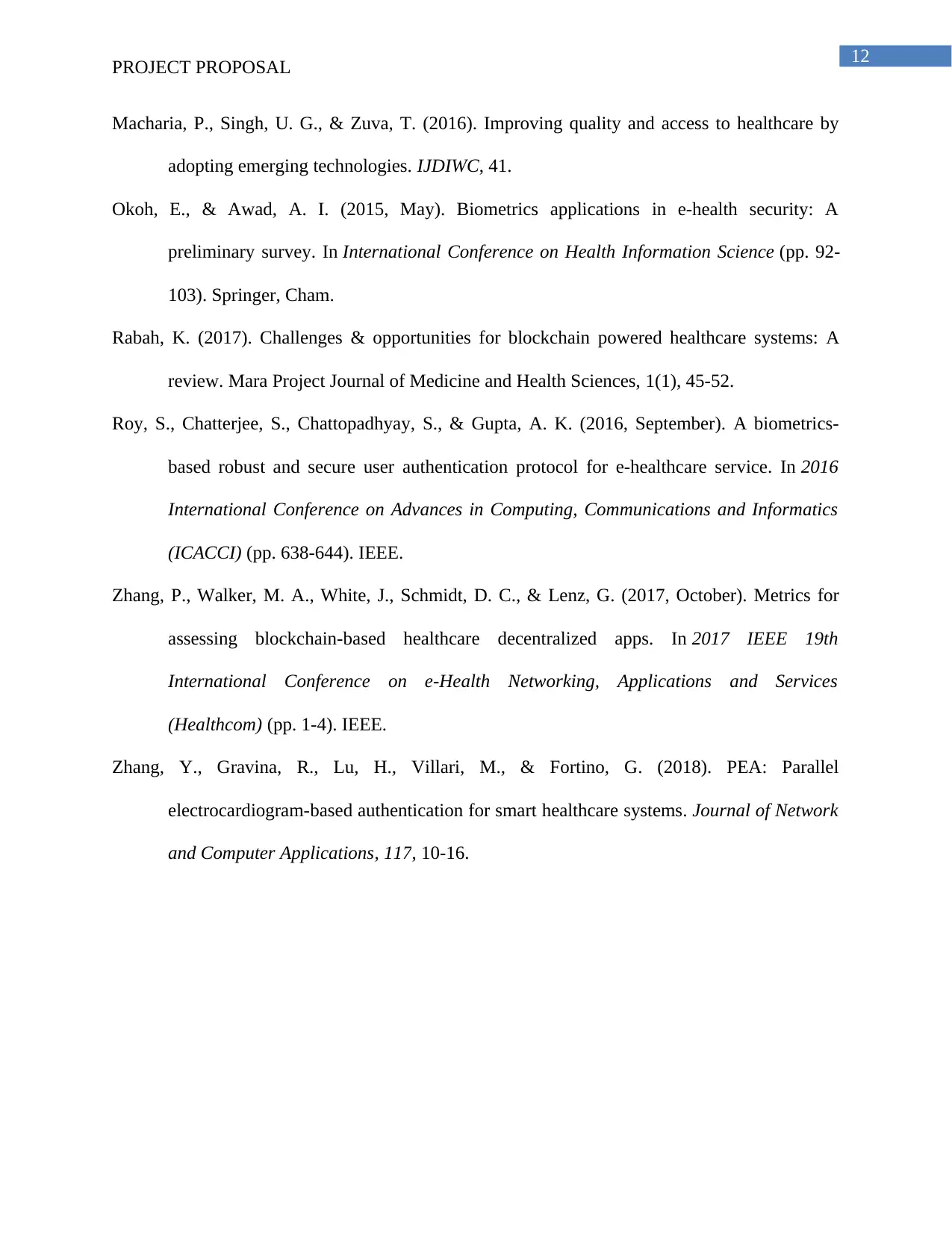
12
PROJECT PROPOSAL
Macharia, P., Singh, U. G., & Zuva, T. (2016). Improving quality and access to healthcare by
adopting emerging technologies. IJDIWC, 41.
Okoh, E., & Awad, A. I. (2015, May). Biometrics applications in e-health security: A
preliminary survey. In International Conference on Health Information Science (pp. 92-
103). Springer, Cham.
Rabah, K. (2017). Challenges & opportunities for blockchain powered healthcare systems: A
review. Mara Project Journal of Medicine and Health Sciences, 1(1), 45-52.
Roy, S., Chatterjee, S., Chattopadhyay, S., & Gupta, A. K. (2016, September). A biometrics-
based robust and secure user authentication protocol for e-healthcare service. In 2016
International Conference on Advances in Computing, Communications and Informatics
(ICACCI) (pp. 638-644). IEEE.
Zhang, P., Walker, M. A., White, J., Schmidt, D. C., & Lenz, G. (2017, October). Metrics for
assessing blockchain-based healthcare decentralized apps. In 2017 IEEE 19th
International Conference on e-Health Networking, Applications and Services
(Healthcom) (pp. 1-4). IEEE.
Zhang, Y., Gravina, R., Lu, H., Villari, M., & Fortino, G. (2018). PEA: Parallel
electrocardiogram-based authentication for smart healthcare systems. Journal of Network
and Computer Applications, 117, 10-16.
PROJECT PROPOSAL
Macharia, P., Singh, U. G., & Zuva, T. (2016). Improving quality and access to healthcare by
adopting emerging technologies. IJDIWC, 41.
Okoh, E., & Awad, A. I. (2015, May). Biometrics applications in e-health security: A
preliminary survey. In International Conference on Health Information Science (pp. 92-
103). Springer, Cham.
Rabah, K. (2017). Challenges & opportunities for blockchain powered healthcare systems: A
review. Mara Project Journal of Medicine and Health Sciences, 1(1), 45-52.
Roy, S., Chatterjee, S., Chattopadhyay, S., & Gupta, A. K. (2016, September). A biometrics-
based robust and secure user authentication protocol for e-healthcare service. In 2016
International Conference on Advances in Computing, Communications and Informatics
(ICACCI) (pp. 638-644). IEEE.
Zhang, P., Walker, M. A., White, J., Schmidt, D. C., & Lenz, G. (2017, October). Metrics for
assessing blockchain-based healthcare decentralized apps. In 2017 IEEE 19th
International Conference on e-Health Networking, Applications and Services
(Healthcom) (pp. 1-4). IEEE.
Zhang, Y., Gravina, R., Lu, H., Villari, M., & Fortino, G. (2018). PEA: Parallel
electrocardiogram-based authentication for smart healthcare systems. Journal of Network
and Computer Applications, 117, 10-16.
1 out of 12
Related Documents
Your All-in-One AI-Powered Toolkit for Academic Success.
+13062052269
info@desklib.com
Available 24*7 on WhatsApp / Email
![[object Object]](/_next/static/media/star-bottom.7253800d.svg)
Unlock your academic potential
© 2024 | Zucol Services PVT LTD | All rights reserved.



